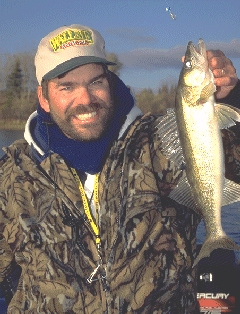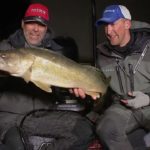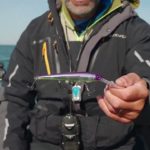Curing Walleye Fever
Are you suffering from a severe form of Cabin Fever known as Walleye Fever? Biter’s Keith Kavajecz and Gary Parsons know the ailment all too well and offer up these tips for getting the cure!
 There’s a mysterious ailment making the rounds throughout walleye country this time of year. No, it’s not the Flu, but it’s much more serious than the common cold. Symptoms range from fatigue, irritability, and increased appetite to the insatiable desire to spend endless hours sharpening hooks, watching TV fishing shows and videos, and pouring over magazines filled with stories describing the newest tackle and techniques for catching fish. It’s Walleye Fever, and if you’re any kind of walleye angler, chances are you are suffering from it to some degree. Some folks try treating the Fever by ice fishing, but that’s sort of like using an ice pack to sooth a spiking temperature … the relief is only temporary. Well fear not, because we have good news … the cure is at hand.
There’s a mysterious ailment making the rounds throughout walleye country this time of year. No, it’s not the Flu, but it’s much more serious than the common cold. Symptoms range from fatigue, irritability, and increased appetite to the insatiable desire to spend endless hours sharpening hooks, watching TV fishing shows and videos, and pouring over magazines filled with stories describing the newest tackle and techniques for catching fish. It’s Walleye Fever, and if you’re any kind of walleye angler, chances are you are suffering from it to some degree. Some folks try treating the Fever by ice fishing, but that’s sort of like using an ice pack to sooth a spiking temperature … the relief is only temporary. Well fear not, because we have good news … the cure is at hand.
If you’re anywhere close to a river that harbors walleyes, now is a great time to hit the water for the season’s first walleye action. Rivers are the first waters to thaw in the spring, and they attract walleyes as they move into potential spawning areas. That makes for good numbers of fish located in predictable areas and that means some really good fishing. But getting out on the river still isn’t medicine enough to cure a true case of Walleye Fever. It takes a full dose of the remedy to truly be cured. In other words, you need to catch some fish, and early season catching calls for the right prescription … or the right tackle and techniques to put the walleyes in the boat.
Location is the first key to finding the cure. Look for walleyes to hold in reduced current areas near spawning flats. These spots are created by some sort of current break like a point or rock jetty jutting out into the channel, a sand bar, a delta caused by an incoming creek, or even the inside corner of a river bend. If you’re fishing near a dam, the outside edges of the spillway often offer reduced current that holds fish. Any of these areas can also create back eddies that are notorious for holding lots of fish. River walleyes prefer some current to bring food to them, but not so much that they have to work too hard to fight it. Even a depression in the bottom can be a holding area, where the fish will lay in wait for a potential meal to pass overhead.
The most efficient tactic to target these early spring walleyes is vertical jigging. This is a technique where the angler fishes a jig (usually tipped with a minnow) directly below the boat while moving down-current in the river. The idea is to keep the presentation as vertical as possible as this will increase your over-all feel allowing the detection of bites and identification of bottom cover as you drift.
 The biggest mistake many anglers make is to try to maintain a vertical presentation by going to a heavy jig. That does two things … it makes it tougher for the fish to take the bait into its mouth, and because you end up fighting the current instead of flowing with it, you don’t present the bait in a way walleyes are used to seeing their prey. They eat things that are traveling the same speed as the current, and that’s the way you want to present your jig. The best way to do this is to use a lighter jig (1/4 to 3/8 ounce are the bread-and-butter sizes), and utilize your bowmount electric motor to “follow your fishing line”. In other words, if you see your line swinging to the left or right, use your bowmount to move the boat until the line is vertical again. We use a technique we call “Bursting” where we set our trolling motor on about 80 % power, and correct the boat’s drift with short powerful bursts. This way we use less time and energy keeping our baits vertical at all times.
The biggest mistake many anglers make is to try to maintain a vertical presentation by going to a heavy jig. That does two things … it makes it tougher for the fish to take the bait into its mouth, and because you end up fighting the current instead of flowing with it, you don’t present the bait in a way walleyes are used to seeing their prey. They eat things that are traveling the same speed as the current, and that’s the way you want to present your jig. The best way to do this is to use a lighter jig (1/4 to 3/8 ounce are the bread-and-butter sizes), and utilize your bowmount electric motor to “follow your fishing line”. In other words, if you see your line swinging to the left or right, use your bowmount to move the boat until the line is vertical again. We use a technique we call “Bursting” where we set our trolling motor on about 80 % power, and correct the boat’s drift with short powerful bursts. This way we use less time and energy keeping our baits vertical at all times.
The style of jig you use will play a key role in your Fever treatment as well. For vertical jigging, a jig with a long hook shank will increase your hooking percentage over those with short shank hooks. The longer shank gives the jig a “cam” action on the hook set that helps to drive the hook into the fish’s mouth. Standard round-head jigs work fine in many cases, but if you are looking to treat your Fever in the best fashion possible, aXPS Walleye Jig jig with a “semi-stand-up” head design definitely offers a few advantages. Bass Pro Shop’s XPS Walleye Angler Jigs and Fin-tech Nuckle Ball Jigs are our favorites in this category. The semi-stand-up style puts the hook and trailing bait just off the bottom in perfect position for a walleye to suck it in with little effort. This is especially helpful when most of your bites are coming as the jig sits on the bottom between jigging motions.
Jig color can be a huge factor in early season fishing. The XPS Walleye Angler Jigs feature unique holographic finishes that emit flash mush the same as a real minnow would in the water. That makes them a great choice in clear to slightly stained water which is common in very early spring (before major run-offs and April showers muddy things up).
The final ingredient in the prescription is to make sure you use fresh, lively minnows to tip your jigs. The better the bait, the better attraction it will hold for the fish. Keeping your bait lively in a quality aerated minnow container will absolutely help you catch more fish. Bait size will also make a difference. Carry a good supply of small to medium size minnows. Depending on the bite and the particular river you are fishing, some days they’ll gobble up small minnows and never touch larger ones, while other days, the bigger bait is the ticket.
It’s been a long winter, and chances are the Walleye Fever has a tight grip on you too. But if there’s a river near by, the cure is as simple to swallow as a leech dipped in olive oil. Just gather up your jigging tackle and head for the water. Once you feel the “tick” and hook into a few dandy walleyes, you will be cured.





